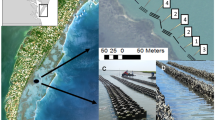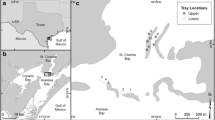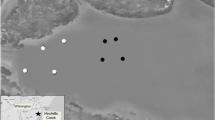Abstract
Oyster reefs are among the most threatened habitats in the world having suffered cosmopolitan decline, and studies evaluating reef construction materials and designs are critical to their successful restoration and management. Current restoration practice commonly employs the use of high-density polyethylene (HDPE) plastic materials to contain oyster shell (cultch); however, as scientists begin to understand more about the problematic ecological and health effects of microplastics in marine environments, testing alternatives to these materials has become increasingly important. In this study, we used biodegradable coconut fiber (coir) materials to construct a network of subtidal oyster reefs and evaluate two reef designs in West Bay, St. Andrew Bay, Florida. These designs differed in the quantity of cultch used and therefore overall reef height. Through an analysis of changes in reef area and reef height, as well as mollusc coverage, density, and size-frequency distribution over a 5-year period, we compare the performance of low- and high-profile reef construction designs and assess the suitability of coir for subtidal oyster reef restoration. Results indicate that a high-profile reef design involving a perimeter wall of coir oyster bags and a loose cultch interior is suitable for creating oyster reef habitat in the low-wave energy, subtidal conditions of St. Andrew Bay. Coir adequately contained cultch until live oysters could colonize the surface, indicating a viable alternative to using HDPE plastic materials in subtidal oyster reef restoration. Results also show the importance of reef height to sustaining oyster habitat at restoration sites subject to mobile sediments.




Similar content being viewed by others
Data Availability
Data for this study are available in the FWC Digital Library repository, https://f50006a.eos-intl.net/F50006A/OPAC/Details/Record.aspx?BibCode=5598669.
References
Akaike, H. 1973. Information theory and an extension of the maximum likelihood principle. In Second Proceedings of the Second International Symposium on Information Theory, ed. B.N. Petrov and F. Csaki, 267–281. Budapest: Akademiai Kiado.
Apeti, D.A., Y. Kim, G. Lauenstein, J. Tull, and R. Warner. 2014. Occurrence of Parasites and Diseases in Oysters and Mussels of the U.S. Coastal Waters. National Status and Trends, the Mussel Watch monitoring program. NOAA Technical Memorandum NOAA/NCCOS 182. Silver Spring, MD 51 pp. https://repository.library.noaa.gov/view/noaa/2708. Accessed 02 Feb 2022.
Baggett, L.P., S.P. Powers, R.D. Brumbaugh, L.D, Coen, B.M. DeAngelis, J.K. Greene, B.T. Hancock, and S. Morlock. 2014. Oyster habitat restoration monitoring and assessment handbook. The Nature Conservancy, Arlington, VA. https://www.conservationgateway.org/ConservationPractices/Marine/Documents/Oyster%20Habitat%20Restoration%20Monitoring%20and%20Assessment%20Handbook.pdf. Accessed 14 June 2019.
Barry, T., F.C. Sutter, K. Benson, M. Gange, M. Hilgart, E. Hutchins, D. Landsman, E. MacMillan, L. Mahan, J. Shenot, H. Schnabolk, and J. Sims. 2015. Final programmatic environmental impact statement for habitat activities implemented throughout the coastal United States. National Oceanic and Atmospheric Administration. https://repository.library.noaa.gov/view/noaa/12463. Accessed 07 Dec 2021.
Beck, M.W., R.D. Brumbaugh, L. Airoldi, A. Carranza, L.D. Coen, C. Crawford, O. Defeo, G.J. Edgar, B. Hancock, M.C. Kay, and H.S. Lenihan. 2011. Oyster reefs at risk and recommendations for conservation, restoration, and management. BioScience 61 (2): 107–116. https://doi.org/10.1525/bio.2011.61.2.5.
Brim, M.S., and L.R. Handley. 2007. Seagrass status and trends in the Northern Gulf of Mexico: 1940–2002. In: Handley L, Altsman D, DeMay R (eds) U.S. Geological Survey Scientific Investigations Report 2006–5287, Pages 155–169. Reston, VA. https://doi.org/10.3133/sir20065287. Accessed 14 June 2019.
Bringer, A., J. Cachot, E. Dubillot, B. Lalot, and H. Thomas. 2021. Evidence of deleterious effects of microplastics from aquaculture materials on pediveliger larva settlement and oyster spat growth of Pacific oyster, Crassostrea gigas. Science of the Total Environment. 794: 148708. https://doi.org/10.1016/j.scitotenv.2021.148708.
Brooks, M.E., K. Kristensen, K.J. van Benthem, A. Magnusson, C.W. Berg, A. Nielsen, H.J. Skaug, M. Machler, and B.M. Bolker. 2017. glmmTMB balances speed and flexibility among packages for zero-inflated generalized linear mixed modeling. The R Journal. 9 (2): 378–400. https://doi.org/10.3929/ethz-b-000240890.
Burnham, K. P., and D.R. Anderson. 2002. Model selection and multimodel inference: a practical information-theoretic approach. Second edition. New York: Springer-Verlag 70 pp.
Burrell, V. G. 1986. Species profiles: Life histories and environmental requirements of coastal fishes and invertebrates (South Atlantic): American oyster. Biological Report 82 (11.57). U.S. Fish and Wildlife Service, Lafayette, LA. http://aquaticcommons.org/3578/1/1986_burr.pdf. Accessed 21 Jan 2022.
Carlson, P., L. Yarbro, L. Johnsey, A. Patranella, C. York, S. Scolaro, M. Poniatowski, M. Mosser, and S. Nappier. 2020. Roadbloacks to seagrass recovery—final report. https://myfwc.com/media/24317/roadblocks-final-report.pdf. Accessed 06 Jan 2022.
Coen, L.D., R.D. Brumbaugh, D. Bushek, R. Grizzle, M.W. Luckenbach, M.H. Posey, S.P. Powers, and S.G. Tolley. 2007. Ecosystem services related to oyster restoration. Marine Ecology Progress Series. 341: 303–307. https://doi.org/10.3354/meps341303.
Coen, L.D., B.R. Dumbauld, and M.L. Judge. 2011. Expanding shellfish aquaculture: a review of the ecological services provided by and impacts of native and cultured bivalves in shellfish-dominated ecosystems. Shellfish aquaculture and the environment. 239-295. https://doi.org/10.1002/9780470960967.ch9
Colden, A.M., K.A. Fall, G.M. Cartwright, and C.T. Friedrichs. 2016. Sediment suspension and deposition across restored oyster reefs of varying orientation to flow: Implications for restoration. Estuaries and Coasts. 39 (5): 1435–1448. https://doi.org/10.1007/s12237-016-0096-y.
Colden, A.M., R.J. Latour, and R.N. Lipcius. 2017. Reef height drives threshold dynamics of restored oyster reefs. Marine Ecology Progress Series. 582: 1–13. https://doi.org/10.3354/meps12362.
Crisp, D.J. 1967. Chemical factors inducing settlement in Crassostrea virginica (Gmelin). The Journal of Animal Ecology. 329-335. https://doi.org/10.2307/2916
Deepwater Horizon Natural Resource Damage Assessment Trustees (DWH Trustees). 2016. Deepwater Horizon oil spill: final programmatic damage assessment and restoration plan and final programmatic environmental impact statement. National Oceanic and Atmospheric Administration, Washington, DC. http://www.gulfspillrestoration.noaa.gov/restoration-planning/gulf-plan. Accessed 06 Aug 2019.
Edmiston, H.L., S.A. Fahrny, M.S. Lamb, L.K. Levi, J.M. Wanat, J.S. Avant, K. Wren, and N.C. Selly. 2008. Tropical storm and hurricane impacts on a Gulf Coast estuary: Apalachicola Bay Florida. Journal of Coastal Research 10055: 38–49. https://doi.org/10.2112/SI55-009.1.
Florida Department of Environmental Protection (FDEP). 2020. Natural resource damage assessment phase III Deepwater Horizon early restoration Florida oyster cultch placement project, Report No. 3. https://pub-data.diver.orr.noaa.gov/restoration/NRDAOysterCultchMonitoringReport_2019_FINAL.pdf. Accessed 21 Jan 2022.
Ford, S.E. and M.R. Tripp. 1996. Diseases and Defense Mechanisms. In The Eastern Oyster: Crassostrea virginica. eds. Kennedy, V.S., R.I.E. Newell, and A.F. Eble, 581–660. College Park, MD: Maryland Sea Grant College.
Goelz, T., B. Vogt, and T. Hartley. 2020. Alternative substrates used for oyster reef restoration: A review. Journal of Shellfish Research. 39 (1): 1–12. https://doi.org/10.2983/035.039.0101.
Hartig, F. 2020. DHARMa: residual diagnostics for hierarchical (Multi-Level / Mixed) regression models. R package version 0.3.3.0. https://CRAN.R-project.org/package=DHARMa. Accessed 13 July 2020.
Hatchell, B., K. Konchar, C. Shea, and B. Furman. 2022. Pilot study for seagrass habitat restoration at West Bay, St. Andrew Bay, Florida. Florida Fish and Wildlife Conservation Commission. https://myfwc.maps.arcgis.com/sharing/rest/content/items/03c64267b7d3462c8c36f431e0c7b56e/data. Accessed 08 Feb 2022.
Henderson, J., and J. O'Neil. 2003. Economic values associated with construction of oyster reefs by the Corps of Engineers. EMRRP Technical Notes Collection (ERDC-TN-EMRRP-ER-01). U.S. Army Engineer Research and Development Center, Vicksburg, MS. https://apps.dtic.mil/dtic/tr/fulltext/u2/a418661.pdf. Accessed 02 Nov 2020.
Herr, A. (2021, June 20). How oysters and seagrass could help the California coast adapt to rising seas. Salon. Retrieved from https://www.salon.com/2021/06/20/how-oysters-and-seagrass-could-help-the-california-coast-adapt-to-rising-seas_partner/. Accessed 21 Jan 2022.
Hidalgo-Ruz, V., L. Gutow, R.C. Thompson, and M. Thiel. 2012. Microplastics in the marine environment: A review of the methods used for identification and quantification. Environmental Science & Technology. 46 (6): 3060–3075. https://doi.org/10.1021/es2031505.
Housego, R.M., and H. Rosman. 2016. A model for understanding the effects of sediment dynamics on oyster reef development. Estuaries and Coasts. 39 (2): 495–509. https://doi.org/10.1007/s12237-015-9998-3.
Hurvich, C.M., and C.L. Tsai. 1989. Regression and time series model selection in small samples. Biometrika 76 (2): 297–307. https://doi.org/10.1093/biomet/76.2.297.
La Peyre, M.K., B.S. Eberline, T.M. Soniat, and J.F. La Peyre. 2013. Differences in extreme low salinity timing and duration differentially affect eastern oyster (Crassostrea virginica) size class growth and mortality in Breton Sound LA. Estuarine. Coastal and Shelf Science 135: 146–157. https://doi.org/10.1016/j.ecss.2013.10.001.
La Peyre, M., J. Furlong, L.A. Brown, B.P. Piazza, and K. Brown. 2014. Oyster reef restoration in the northern Gulf of Mexico: Extent, methods and outcomes. Ocean & Coastal Management. 89: 20–28. https://doi.org/10.1016/j.ocecoaman.2013.12.002.
Lavan, B. 2019. Examining the effect of interstitial space on Eastern oysters (Crassostrea virginica): applications of photogrammetry and three-dimensional modeling. https://core.ac.uk/download/pdf/223059018.pdf. Accessed 13 Dec 2021.
Lenihan, H.S. 1999. Physical–biological coupling on oyster reefs: How habitat structure influences individual performance. Ecological Monographs. 69 (3): 251–275. https://doi.org/10.1890/0012-9615(1999)069[0251:PBCOOR]2.0.CO;2.
Lenth, R. 2019. Emmeans: estimated marginal means, aka least-squares means. R package version 1.4.3.01. https://CRAN.R-project.org/package=emmeans. Accessed 13 July 2020.
Levine, E.A., J.S., Gosnell, E.M. Goetz, and C.R. Malinowski. 2017. Natural cultch type influences habitat preference and predation, but not survival, in reef-associated species. Restoration Ecology. 25 (1): 101–111. https://doi.org/10.1111/rec.12385.
Madden, C.J., D.T. Rudnick, A.A. McDonald, K.M. Cunniff, and J.W. Fourqurean. 2009. Ecological indicators for assessing and communicating seagrass status and trends in Florida Bay. Ecological Indicators. 9 (6): S68–S82. https://doi.org/10.1016/j.ecolind.2009.02.004.
Menzel, R.W., N.C. Hulings, and R.R. Hathaway. 1966. Oyster abundance in Apalachicola Bay, Florida in relation to biotic associations influenced by salinity and other factors. Gulf and Caribbean Research. 2.2: 73–96. https://doi.org/10.18785/grr.0202.01.
Northwest Florida Water Management District (NWFWMD). 2017. St. Andrew Bay watershed surface water improvement and management plan. Program Development Series 17–08. Havana, FL. https://www.nwfwater.com/Water-Resources/Surface-Water-Improvement-and-Management. Accessed 27 Jan 2021.
Pace, S.M., L.M. Poussard, E.N. Powell, K.A. Ashton-Alcox, K.M. Kuykendall, L.K. Solinger, K.M. Hemeon, and T.M. Soniat. 2020. Dying, decaying, and dissolving into irrelevance: First direct in-the-field estimate of Crassostrea virginica shell loss—a case history from Mississippi Sound. Journal of Shellfish Research. 39 (2): 245–256. https://doi.org/10.2983/035.039.0206.
Parker, M., M. Davis, and T. Scholze. 2019. Oyster monitoring and restoration efforts in Apalachicola Bay, Florida. Florida Fish and Wildlife Research Institute. https://ocean.floridamarine.org/OIMMP/Resources_2019/15_Parker.pdf. 25 Sept 2020.
Parker, M.L., W.S. Arnold, S.P. Geiger, P. Gorman, and E.H. Leone. 2013. Impacts of freshwater management activities on eastern oyster (Crassostrea virginica) density and recruitment: Recovery and long-term stability in seven Florida estuaries. Journal of Shellfish Research. 32 (3): 695–708. https://doi.org/10.2983/035.032.0311.
Partnership for the Delaware Estuary. 2013. Living shorelines in the Delaware Estuary: best practices from lessons learned and information collected by the partnership for the Delaware Estuary and the Haskin Shellfish Research Laboratory, 2008 -2012. PDE Report No. 13–04. https://delawareestuary.s3.amazonaws.com/pdf/Living%20Shorelines/living_shorelines_best_practices.pdf. Accessed 07 Dec 2021.
Powell, E.N., J.N. Kraeuter, and K.A. Ashton-Alcox. 2006. How long does oyster shell last on an oyster reef? Estuarine, Coastal and Shelf Science. 69: 531–542. https://doi.org/10.1016/j.ecss.2006.05.014.
Powers, S.P., C.H. Peterson, J.H. Grabowski, and H.S. Lenihan. 2009. Success of constructed oyster reefs in no-harvest sanctuaries: Implications for restoration. Marine Ecology Progress Series. 389: 159–170. https://doi.org/10.3354/meps08164.
Radabaugh, K.R., S.P. Geiger, and R.P. Moyer. 2019. Oyster integrated mapping and monitoring program report for the State of Florida. St. Petersburg, FL. Fish and Wildlife Research Institute, Florida Fish and Wildlife Conservation Commission. FWRI Technical Report 22. https://myfwc.com/media/22097/oimmp-report-2019.pdf. Accessed 01 Jan 2022.
R Core Team. 2019. R: A language and environment for statistical computing. Vienna, Austria: R Foundation for Statistical Computing.
Rybovich, M., M.K. La Peyre, S.G. Hall, and J.F. La Peyre. 2016. Increased temperatures combined with lowered salinities differentially impact oyster size class growth and mortality. Journal of Shellfish Research. 35 (1): 101–113. https://doi.org/10.2983/035.035.0112.
Smithson, M., and J. Verkuilen. 2006. A better lemon squeezer? Maximum-likelihood regression with beta-distributed dependent variables. Psychological Methods. 11 (1): 54–71. https://doi.org/10.1037/1082-989x.11.1.54.
Soniat, T.M. 1996. Epizootiology of Perkinsus marinus disease of eastern oysters in the Gulf of Mexico. Oceanographic Literature Review. 12(43): 1265. https://www.infona.pl/resource/bwmeta1.element.elsevier-6cd05af0-3de6-3be5-9ebf-446eb102b17f. Accessed 25 Jan 2022.
Soucy, B. 2020. Alternative material selection for oyster restoration with an emphasis on living docks. https://repository.lib.fit.edu/bitstream/handle/11141/3177/SOUCY-THESIS-2020.pdf?sequence=1&isAllowed=y. Accessed 08 Dec 2021.
Sussarellu, R., M. Suquet, Y. Thomas, C. Lambert, C. Fabioux, M.E.J. Pernet, N. Le Goic, V. Quillien, C. Mingant, Y. Epelboin, C. Corporeau, J. Guyomarch, J. Robbens, I. Paul-Point, P. Soudant, and C. Corporeau. 2016. Oyster reproduction is affected by exposure to polystyrene microplastics. Proceedings of the National Academy of Sciences. 113 (9): 2430–2435. https://doi.org/10.1073/pnas.1519019113.
Taylor, J., and D. Bushek. 2008. Intertidal oyster reefs can persist and function in a North American Atlantic estuary. Marine Ecology Progress Series. 361: 301–306. https://doi.org/10.3354/meps07429.
Thyavihalli Girijappa, Y.G., S. Mavinkere Rangappa, J. Parameswaranpillai, and S. Siengchin. 2019. Natural fibers as sustainable and renewable resource for development of ecofriendly composites: A comprehensive review. Frontiers in Materials. 6: 226. https://doi.org/10.3389/fmats.2019.00226.
VanderKooy, S. 2012. The Oyster Fishery of the Gulf of Mexico, United States: a regional management plan—2012 Revision. Gulf States Marine Fisheries Commission Publication No. 202, Ocean Springs, MS. https://www.researchgate.net/profile/Steve_Vanderkooy/publication/294873659_The_oyster_fishery_of_the_Gulf_of_Mexico_United_States_A_regional_management_plan-2012_revision/links/5b7dc279a6fdcc5f8b5c546f/The-oyster-fishery-of-the-Gulf-of-Mexico-United-States-A-regional-management-plan-2012-revision.pdf. Accessed 25 June 2019.
Waite, H.R., M.J. Donnelly, and L.J. Walters. 2018. Quantity and types of microplastics in the organic tissues of the eastern oyster Crassostrea virginica and Atlantic mud crab Panopeus herbstii from a Florida estuary. Marine Pollution Bulletin. 129 (1): 179–185. https://doi.org/10.1016/j.marpolbul.2018.02.026.
Wang, H., W. Huang, M.A. Harwell, L. Edmiston, E. Johnson, P. Hsieh, K. Milla, J. Christensen, J. Stewart, and X. Liu. 2008. Modeling oyster growth rate by coupling oyster population and hydrodynamic models for Apalachicola Bay, Florida, USA. ecological modelling. 211(1–2): 77–89. https://doi.org/10.1016/j.ecolmodel.2007.08.018.
zu Ermgassen, P.S., M.D. Spalding, B. Blake, L.D. Coen, B. Dumbauld, S. Geiger, J.H. Grabowski, R. Grizzle, M. Luckenbach, K. McGraw, W. Rodney, J.L. Ruesink, S.P. Powers, and W. Rodney. 2012. Historical ecology with real numbers: Past and present extent and biomass of an imperilled estuarine habitat. Proceedings of the Royal Society B: Biological Sciences. 279 (1742): 3393–3400. https://doi.org/10.1098/rspb.2012.0313.
Acknowledgements
This project was funded by the National Fish and Wildlife Foundation (Award #8006.14.040897) and the State of Florida’s Marine Resources and Conservation Trust Fund. Special thanks to all volunteers who tirelessly contributed over 1400 h to fill coir oyster bags and build oyster mattresses. We gratefully acknowledge Jacob Berninger for his assistance with monitoring and data management from 2016 to 2018. We also thank Matthew Davis and Annie Roddenberry who contributed valuable time and effort to review and edit previous versions of this manuscript. We also would like to extend our appreciation to Mike Hunter (FWC’s Office of Community Relations) for his artistic assistance on Figs. 1 and 2 and to Chris Anderson (FWC’s Center for Spatial Analysis) for cartographic assistance with Fig. 1.
Author information
Authors and Affiliations
Corresponding author
Ethics declarations
Conflict of Interest
The authors declare no conflict of interest.
Additional information
Communicated by Eric N. Powell
Rights and permissions
About this article
Cite this article
Hatchell, B., Konchar, K., Merrill, M. et al. Use of Biodegradable Coir for Subtidal Oyster Habitat Restoration: Testing Two Reef Designs in Northwest Florida. Estuaries and Coasts 45, 2675–2689 (2022). https://doi.org/10.1007/s12237-022-01094-6
Received:
Revised:
Accepted:
Published:
Issue Date:
DOI: https://doi.org/10.1007/s12237-022-01094-6




